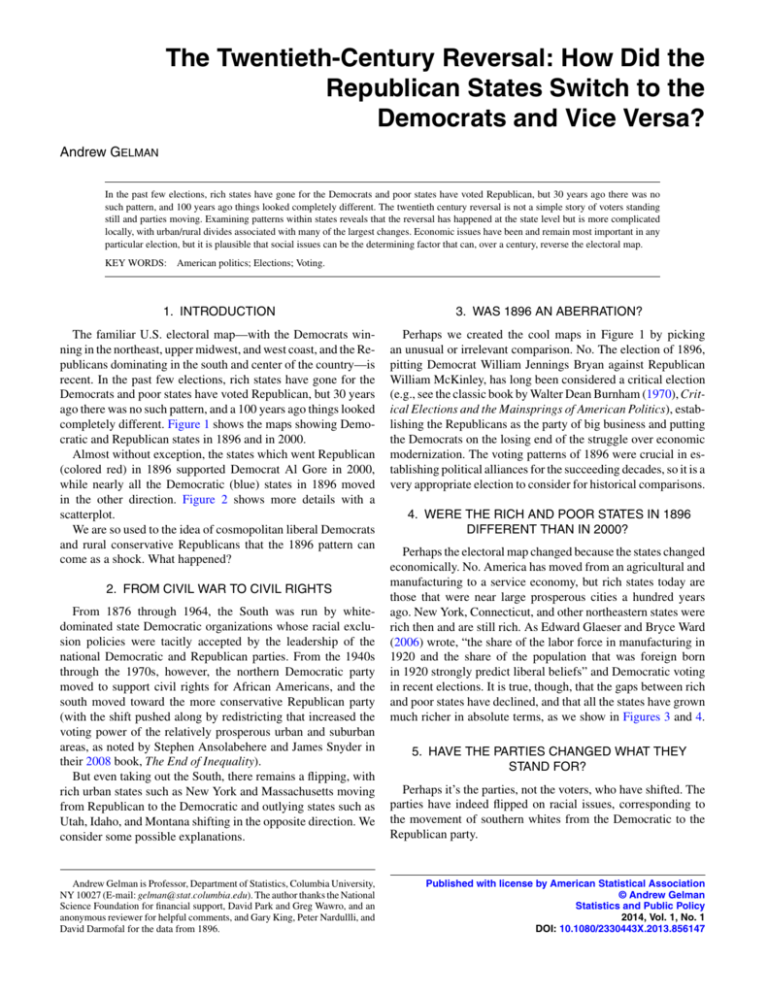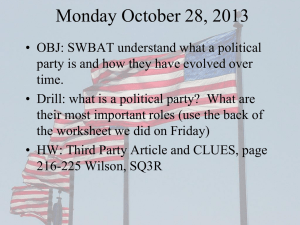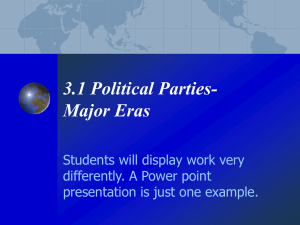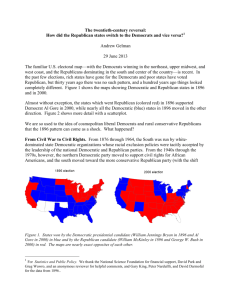The Twentieth-Century Reversal
advertisement

The Twentieth-Century Reversal: How Did the Republican States Switch to the Democrats and Vice Versa? Andrew GELMAN In the past few elections, rich states have gone for the Democrats and poor states have voted Republican, but 30 years ago there was no such pattern, and 100 years ago things looked completely different. The twentieth century reversal is not a simple story of voters standing still and parties moving. Examining patterns within states reveals that the reversal has happened at the state level but is more complicated locally, with urban/rural divides associated with many of the largest changes. Economic issues have been and remain most important in any particular election, but it is plausible that social issues can be the determining factor that can, over a century, reverse the electoral map. Downloaded by [86.144.59.151] at 12:10 30 December 2013 KEY WORDS: American politics; Elections; Voting. 1. INTRODUCTION 3. WAS 1896 AN ABERRATION? The familiar U.S. electoral map—with the Democrats winning in the northeast, upper midwest, and west coast, and the Republicans dominating in the south and center of the country—is recent. In the past few elections, rich states have gone for the Democrats and poor states have voted Republican, but 30 years ago there was no such pattern, and a 100 years ago things looked completely different. Figure 1 shows the maps showing Democratic and Republican states in 1896 and in 2000. Almost without exception, the states which went Republican (colored red) in 1896 supported Democrat Al Gore in 2000, while nearly all the Democratic (blue) states in 1896 moved in the other direction. Figure 2 shows more details with a scatterplot. We are so used to the idea of cosmopolitan liberal Democrats and rural conservative Republicans that the 1896 pattern can come as a shock. What happened? Perhaps we created the cool maps in Figure 1 by picking an unusual or irrelevant comparison. No. The election of 1896, pitting Democrat William Jennings Bryan against Republican William McKinley, has long been considered a critical election (e.g., see the classic book by Walter Dean Burnham (1970), Critical Elections and the Mainsprings of American Politics), establishing the Republicans as the party of big business and putting the Democrats on the losing end of the struggle over economic modernization. The voting patterns of 1896 were crucial in establishing political alliances for the succeeding decades, so it is a very appropriate election to consider for historical comparisons. 4. WERE THE RICH AND POOR STATES IN 1896 DIFFERENT THAN IN 2000? Perhaps the electoral map changed because the states changed economically. No. America has moved from an agricultural and manufacturing to a service economy, but rich states today are those that were near large prosperous cities a hundred years ago. New York, Connecticut, and other northeastern states were rich then and are still rich. As Edward Glaeser and Bryce Ward (2006) wrote, “the share of the labor force in manufacturing in 1920 and the share of the population that was foreign born in 1920 strongly predict liberal beliefs” and Democratic voting in recent elections. It is true, though, that the gaps between rich and poor states have declined, and that all the states have grown much richer in absolute terms, as we show in Figures 3 and 4. 2. FROM CIVIL WAR TO CIVIL RIGHTS From 1876 through 1964, the South was run by whitedominated state Democratic organizations whose racial exclusion policies were tacitly accepted by the leadership of the national Democratic and Republican parties. From the 1940s through the 1970s, however, the northern Democratic party moved to support civil rights for African Americans, and the south moved toward the more conservative Republican party (with the shift pushed along by redistricting that increased the voting power of the relatively prosperous urban and suburban areas, as noted by Stephen Ansolabehere and James Snyder in their 2008 book, The End of Inequality). But even taking out the South, there remains a flipping, with rich urban states such as New York and Massachusetts moving from Republican to the Democratic and outlying states such as Utah, Idaho, and Montana shifting in the opposite direction. We consider some possible explanations. 5. HAVE THE PARTIES CHANGED WHAT THEY STAND FOR? Perhaps it’s the parties, not the voters, who have shifted. The parties have indeed flipped on racial issues, corresponding to the movement of southern whites from the Democratic to the Republican party. Published with license by American Statistical Association © Andrew Gelman Statistics and Public Policy 2014, Vol. 1, No. 1 DOI: 10.1080/2330443X.2013.856147 Andrew Gelman is Professor, Department of Statistics, Columbia University, NY 10027 (E-mail: gelman@stat.columbia.edu). The author thanks the National Science Foundation for financial support, David Park and Greg Wawro, and an anonymous reviewer for helpful comments, and Gary King, Peter Nardullli, and David Darmofal for the data from 1896. 1 2 Statistics and Public Policy, 2014 Downloaded by [86.144.59.151] at 12:10 30 December 2013 Figure 1. States won by the Democratic presidential candidates (William Jennings Bryan in 1896 and Al Gore in 2000) in blue and by the Republican candidates (William McKinley in 1896 and George W. Bush in 2000) in red. The maps are nearly exact opposites of each other. On issues of economic policy and income redistribution, however, the relative positions of the two parties have not changed so much. Liberal Republicans have disappeared and conservative Democrats have diminished in number, but even back in 1896 it was the Republican party that was more economically rightleaning in 1896. Then, as now, the Republican Party supported big business and Democrats took the side of labor. The major economic policy difference compared to that of today may be trade: Republicans have traditionally favored tariffs, with the Democrats supporting free trade. Franklin Roosevelt lowered tariffs during his presidency. But by 1993, when Bill Clinton pushed for the ratification of the North American Free Trade Agreement, it was against the opposition of organized labor and a majority of the Democrats in Congress, and free trade is now more strongly associated with the Republicans. Then and now, however, it has been Republicans who are more supportive Figure 2. Republican share of the two-party vote by state in the presidential elections of 1896 and 2000. The rankings of states are nearly reversed, and the negative correlation remains after excluding the south. Figure 3. Average income by state (adjusted for inflation) over most of the past century. Each line on the graph shows a different state. Incomes have increased dramatically in all states, but the relative positions of the states have changed little. Connecticut, Ohio, and Mississippi are highlighted to show the trajectories of rich, middle-income, and poor states. From Gelman et al. (2009). Figure 4. Trends in relative state incomes. The gap between rich and poor states narrowed until about 1980 but has remained steady or widened since then. (The state whose per capita income jumped so high in the 1970s is Alaska.) From Gelman et al. (2009). Gelman: The Twentieth-Century Reversal: How Did the Republican States Switch to the Democrats and Vice Versa? of, and more supported by, business, and Democrats with more liberal policies. 3 and Snyder (2006) discussed the evidence that voters continue to weigh economic concerns strongly when deciding their votes. 7. URBAN/RURAL DIVIDES 6. HAVE VOTERS CHANGED THEIR PRIORITIES? So, what has happened in 100 years that moved Utah and Idaho from 75% Democratic support to 75% Republican, and that has moved New York, Massachusetts, and other northeastern states in the other direction? We gain some insight by looking at election returns within states. Figure 5 shows votes by county in 1896 and 2000, within each of the 12 states in 2000. The correlation between votes then and votes now is positive in some states, negative in others. Each county in Figure 5 is indicated by an oval whose size is proportional to the number of voters. In recent years, the largest counties—which are generally in or near the largest cities—have strongly supported the Democrats. For example, Manhattan, Brooklyn, and the Bronx anchor the bottom of the graph for New York, each giving George W. Bush Downloaded by [86.144.59.151] at 12:10 30 December 2013 We do not have poll data from 100 years ago, but our impression from reading the political history of that period (e.g., Wiebe 1967) is that there have been some changes in the issues that seem most important. Racial politics were extremely important in the late 1800s (especially in the South) and remain important today—but the two parties have switched sides. Then it was the Republicans, now it is the Democrats, who have the support of African Americans. Beyond this, though, we suspect that economic issues were as important then as now. Bill Clinton campaigned on “the economy, stupid,” and at the close of the 1800s political debates centered on the gold standard, tariffs, and other aspects of economic policy. Ansolabehere, Rodden, Figure 5. Republican vote share by county in 1896 and 2000, within each of the twelve largest states (shown here in descending order of population in 2000). Within each state, each county is represented by an ellipse whose width and height are proportional to the square root of its voter turnout (relative to that in the entire state) in 1896 and 2006, respectively. For example, the wide oval at the bottom of the California graph represents San Francisco, which was the most populous county in the state in 1896. The large tall oval a bit above San Francisco is Los Angeles, currently California’s largest county. Both counties split roughly 50/50 in 1896 but have supported the Democrats more strongly in recent years, San Francisco more than Los Angeles. 4 Statistics and Public Policy, 2014 Downloaded by [86.144.59.151] at 12:10 30 December 2013 Figure 6. Republican vote share by county in 1896 and 2000, within the states where the between-county correlation of partisan vote shares were highest (ranging from 0.73 in Rhode Island to 0.51 in Utah). The ellipses represent the number of voters in each county as a proportion of the state’s voters, as detailed in the caption of Figure 5. Figure 7. Republican vote share by county in 1896 and 2000, within four of the five states where the between-county correlation of partisan vote shares were highest in the negative direction (ranging from 0.81 in Delaware to 0.52 in Washington); California, the state with the fourth most negative correlation, is already shown in Figure 5. The ellipses represent the number of voters in each county as a proportion of the state’s voters, as detailed in the caption of Figure 5. in the neighborhood of 20% of the vote. Back in 1896, these urban counties varied in their leanings by state. New York, with its famous Tammany Hall, was an evenly divided county in an otherwise Republican-leaning state; while California’s largest cities split straight down the middle; Chicago leaned Republican; and Philadelphia was an unusual city with a Republican-dominated political “machine.” As Miller and Schofield (2003) wrote, the Democrats of 1896 relied on rural votes and had not yet formed the urban coalition that ultimately brought Franklin Roosevelt to power. Rodden (2008) found that urbanites are politically on the left in most countries around the world, but in the United States this has shown up at the ballot box more in some eras than in others. The states with the highest positive correlation between county votes in 1896 and 2000 are Rhode Island, Tennessee, Colorado, and Utah (see, Figure 6), and the states with the highest negative correlations of county votes are Delaware, Oregon, Nevada, California, and Washington (see, Figure 7). Negative correlations seem easy to understand as the switching of the urban/rural division; it is not so clear how to interpret the strong positive correlations such as occur, for example, in Tennessee (and also in Kentucky, not shown here). Possibly these represent regional patterns within states or anomalies of the particular elections in question. 8. CLOSE ELECTIONS Another puzzling aspect of the Great American Reversal is the reappearance of nearly tied elections. Here is a list of all the U.S. presidential elections that were decided by less than 1% of the popular vote: 1880, 1884, 1888, 1960, 1968, 2000. The other closest elections were 1844 (decided by 1.5% of the vote), 1876 (3%), 1916 (3%), 1976 (2%), and 2004 (2.5%). Four straight close elections in the 1870s–1880s, five close elections since 1960, and almost none at any other time. From the standpoint of political theory, we would expect elections to generally be close: each party has an electoral incentive to move toward the center to capture wavering votes. But over long stretches of American history, close presidential elections have not been the norm. One possible explanation is that after the 1880s the Democrats were largely satisfied with control over the south, along with the political machines of New York and other large cities; national politics were less important in that period except as a way of brokering regional disputes. Since the New Deal, however, federal policy and dollars have been important enough for both parties to seriously contest national elections whenever possible (Ferguson 1995). Politics today is centered around national media and polling, whereas a hundred years ago voters were reached locally. Gelman: The Twentieth-Century Reversal: How Did the Republican States Switch to the Democrats and Vice Versa? Downloaded by [86.144.59.151] at 12:10 30 December 2013 9. CONCLUSIONS The twentieth century reversal is not a simple story of voters standing still and parties moving—the Republicans were the pro-business conservative party in the days of William McKinley and they remain that today. Nor is it an economic reversal of fortune: the industrial eastern and midwestern states that are rich today were even richer, relative to the rest of the country, at the beginning of the twentieth century. The parties’ coalitions have dissolved and reassembled, with blacks moving from the Republican to the Democratic Party, and southern and rural whites moving in the other direction. Examining patterns within states reveals that the reversal has happened at the state level but is more complicated locally. In the wake of suburbanization, inner-city voters both rich and poor have become a more solid block for the Democrats than they ever were in the classic era of urban machine politics. We are used to our current political divides, but in many ways the political alignment of 1896 also makes economic sense, with the richer northeastern states supporting more conservative economic policies. Many of the difficulties in understanding these patterns arise from a fundamental tension that voters in richer regions of the country can be more liberal than those in poorer regions, especially on social issues, a pattern we discussed in our Red State, Blue State book (Gelman et al. 2009). Even in a world in which parties have static positions on issues, there is no obvious way that liberal New Yorkers, say, should vote: should they follow the 1896 pattern and support business-friendly policies that favor local industries, or should they vote as they do now and support higher taxes, which ul- 5 timately redistribute money to faraway states with more conservative values? A similar conundrum befalls a conservative Mississippian or Kansan in the other direction. In that sense, it perhaps is plausible that, although economic issues have been and remain most important in any particular election, social issues can be the determining factor that can, over a century, reverse the electoral map. The tentativeness of this conclusion implies there is room for further research on this topic, moving beyond the usual discussions of economic and racial politics. [Received May 2013. Revised September 2013.] REFERENCES Ansolabehere, S., Rodden, J., and Snyder, J. (2006), “Purple America,” Journal of Economic Perspectives, 20, 97–118. [3] ——— (2008), The End of Inequality, New York: W. W. Norton. [1] Burnham, W. D. (1970), Critical Elections and the Mainsprings of American Politics, New York: W. W. Norton. [1] Ferguson, T. (1995), Golden Rule: The Investment Theory of Party Competition and the Logic of Money-Driven Political Systems, Chicago, IL: University of Chicago Press. [4] Gelman, A., Park, D., Shor, B., and Cortina, J. (2009), Red State, Blue State, Rich State, Poor State: Why Americans Vote the Way They Do (2nd ed.), Princeton, NJ: Princeton University Press. [2,5] Glaeser, E., and Ward, B. (2006), “Myths and Realities of American Political Geography,” Journal of Economic Perspectives, 20, 119–144. [1] Miller, G., and Schofield, N. (2003), “Activists and Partisan Realignment in the United States,” American Political Science Review, 97, 245–260. [4] Rodden, J. (2008), Political Geography and Electoral Rules: Why SingleMember Districts Are Bad for the Left, Manuscript in progress. [4] Wiebe, R. H. (1967), The Search for Order, 1877–1920, New York: Hill and Wang. [3]







